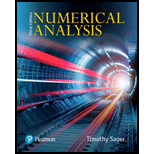
If we also fix the free end of the diving board, we have a “clamped -clamped” beam, obeying
identical boundary conditions at each end:
. where
Want to see the full answer?
Check out a sample textbook solution
Chapter 2 Solutions
Numerical Analysis
- Find an equation of the tangent line to the parabola y=3x2 at the point 1,3.arrow_forwardFind equations for the lines tangent and normal to the cissoid of Diocles y(4 - x) = 9x° at (2,6).arrow_forward5) A spherical storage tank has a radius of 3 feet, and half of it is underground: The equation of the curve in this drawing is x2+y²=9. The tank is full of a fluid having a weight density of w . How much Ib work is required to pump all the fluid up to the top of the tank? [The answer will be an expression containing w.]arrow_forward
 Trigonometry (MindTap Course List)TrigonometryISBN:9781337278461Author:Ron LarsonPublisher:Cengage Learning
Trigonometry (MindTap Course List)TrigonometryISBN:9781337278461Author:Ron LarsonPublisher:Cengage Learning
